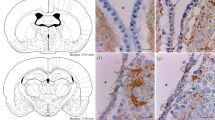Abstract
The aim of this work was to detect the immunohistochemical calcium- binding protein parvalbumin and marker of neural stem cell differentiation β‑III‑tubulin in the cells of the subventricular zone during the neonatal period in rats (five and ten postnatal days). It is shown that, in the subventricular zone, there are cells expressing β-III-tubulin, which are represented by one morphological cell type and are immature differentiating neuroblasts (type A). The number of such cells remains constant during the neonatal period and accounts for more than 30% of the total number of cells in the subventricular zone. It was revealed that a significant part of differentiating neuroblasts express parvalbumin. The number of such cells is more than 20% of the total number of cells of all types and is constant during the neonatal period.



Similar content being viewed by others
REFERENCES
Anderson, D.J., Stem cells and pattern formation in the nervous system: the possible versus the actual, Neuron, 2001, vol. 30, p. 19.
Bolteus, A.J. and Bordey, A., GABA release and uptake regulate neuronal precursor migration in the postnatal subventricular zone, J. Neurosci., 2004, vol. 24, p. 7623.
Conover, J.R. and Notti, Q., The neural stem cell niche, Cell Tiss. Res., 2008, vol. 331, p. 211.
Gabbott, P.L.A. and Bacon, S.J., Local circuit neurons in the medial prefrontal cortex (areas 24 a, b, c, 25, 32) in the monkey, 1. Cell morphology and morphometrics, J. Comp. Neurol., 1996, vol. 364, p. 567.
Inta, I.D., Alfonso, .J, von, Engelhardt, J., Kreuzberg, M.M., Meyer, A.H., van, Hooft, J.A, and Monyer, H., Neurogenesis and widespread forebrain migration of distinct GABAergic neurons from the postnatal subventricular zone, Proc. Natl. Acad. Sci. U. S. A., 2008, vol. 105, p. 209949.https://doi.org/10.1073/pnas.0807059105
Kay, R.B., and Brunjes, P.C., Diversity among principal and GABAergic neurons of the anterior olfactory nucleus, Front. Cell Neurosci., 2014, vol. 8, p. 111.
Korzhevsky, D.E., Petrova, E.S., and Kirik, O.V., Neuronal the markers used at studying of a differentiation of stem cells, Klet. Transplantol. Tkan. Inzh., 2010, vol. 5, no. 3, p. 1.
Liu, H.H. and Brady, S.T., CAMP, tubulin, axonal transport and regeneration, Exp. Neurol., 2004, vol. 189, p. 199. https://doi.org/10.1016/j.expneurol.2004.06,006
Merkle, F.T., Mirzadeh, Z., and Alvarez-Buylla, A., Mosaic organization of neural stem cells in the adult brain, Science, 2007, vol. 317, p. 381.
Ming, G. and Song, H., Adult neurogenesis in the mammalian brain, significant answers and significant questions, Neuron, 2011, vol. 70, p. 687.
Mu, Y., Lee, S.W., and Gate, F., Signaling in adult neurogenesis, Curr. Opin. Neurobiol., 2010, vol. 20, p. 416.
Obukhov, D.K., Tsehmistrenko, T.A., Puschhina, E.V., and Varaksin, A.A., The formation of population of neurons and glia in the pre- and postnatal development of the CNS of vertebrates, Morfologiia, 2019, vol. 156, no. 6, p. 57.
Paxinos, G. and Watson, C., The Rat Brain in Stereotaxic Coordinates, London: Press, 1998.
Platel, J.-C., Stamboulian, S., Nguyen, I., and Bordey, A., Neurotransmitter signaling in postnatal neurogenesis: the first leg, Brain Res. Rev., 2010, vol. 63, p. 60.https://doi.org/10.1016/j.brainresrev.2010.02.004
Scheffler, B., Walton, N.M., Lin, D.D., Goetz, A.K., Enikolopov, G., Roper, S.N., and Steindler, D.A., Phenotypic and functional characterization of adult brain neuropoiesis, Proc. Natl. Acad. Sci. U. S. A., 2005, vol. 102, p. 9353.
Schuurmans, C., Armant, O., Nieto, M., Stenman, J.M., Britz, O., Klenin, N., Brown, C., Langevin, L.-M., Steibt, J., Tang, H., Cunningham, J.M., Dyck, R., Walsh, C., Campbell, K., Polleux, F., and Guillemot, F., Sequential phases of cortical specification involve neurogenin-dependent and -independent pathways, EMBO J., 2004, vol. 23, p. 2892.
Sequerra, E.B., Gardino, P., Hedin-Pereira, C., and de Mello, F.G., Putrescine as an important source of GABA in the postnatal rat subventricular zone, Neuroscience, 2007, vol. 146, p. 489.https://doi.org/10.1016/j.neuroscience.2007.01.062
Sequerra, E.B., Miyakoshi, L.M., Froґes, M.M., Menezes, J.R.L., and Hedin-Pereira, C., Generation of glutamatergic neurons from postnatal and adult subventricular zone with pyramidal-like morphology, Cereb. Cortex, 2010, vol. 20, p. 2583.
Zaitsev, A.V., Gonzales-Burgos, G., Povysheva, N.V., Kroner, S., Lewis, D.A., and Krimer, L.S., Localization of calcium-binding proteins in physiologically and morphologically characterized interneurons in monkey prefrontal cortex, Cereb. Cortex, 2005, vol. 15, p. 1178.
Zinchenko, V.P., Turovskaya, M.V., Teplov, I.Yu., Berezhnov, A.V., and Turovsky, E.A., A role of parvalbumin-containing interneurons in regulation of spontaneous synchronous activity of the brain neurons in culture, Biophysics (Moscow), 2016, vol. 61, no. 1, p. 102.
Funding
This work was financially supported by the Russian Foundation for Basic Research, project no. 20-015-00052.
Author information
Authors and Affiliations
Corresponding author
Ethics declarations
Conflict of interest. The author declares that he has no conflict of interest.
Statement on the welfare of animals. All procedures with animals were carried out in accordance with the “Rules for Working with Experimental Animals” and in compliance with the requirements of the Council of the European Community (86/609/EEC) on the use of laboratory animals. Experimental protocols were approved by the Commission for the Humane Treatment of Animals of the Pavlov Institute of Physiology, Russian Academy of Sciences.
Rights and permissions
About this article
Cite this article
Khozhai, L.I. Expression of Parvalbumin and β-III-Tubulin in Cells of the Subventricular Zone during the Neonatal Period in Rats. Cell Tiss. Biol. 15, 287–292 (2021). https://doi.org/10.1134/S1990519X21030056
Received:
Revised:
Accepted:
Published:
Issue Date:
DOI: https://doi.org/10.1134/S1990519X21030056




